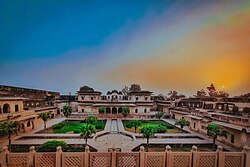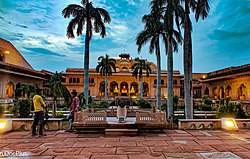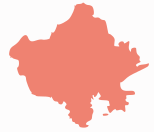Bharatpur district | |
|---|---|
Clockwise from top-left: Deeg Palace, cliffs at Bayana, Government Museum, Bharatpur, Keoladeo National Park, Statue of Maharaja Surajmal at Lohagarh Fort | |
 Location of Bharatpur district in Rajasthan | |
| Country | |
| State | Rajasthan |
| Division | Bharatpur |
| Headquarters | Bharatpur |
| Government | |
| • Divisional Commissioner | Sanwar Mal Verma, IAS [1] |
| • District Collector & Magistrate | Dr. Amit Yadav, IAS [1] |
| Area | |
• Total | 5,066 km2 (1,956 sq mi) |
| Population (2011) [2] | |
• Total | 2,548,462 |
| • Density | 503.1/km2 (1,303/sq mi) |
| Time zone | UTC+05:30 (IST) |
| Website | Bharatpur District |
Bharatpur district is a district in Rajasthan state in western India. The city of Bharatpur is the District Headquarters, Division Headquarters and Headquarters of Bharatpur





